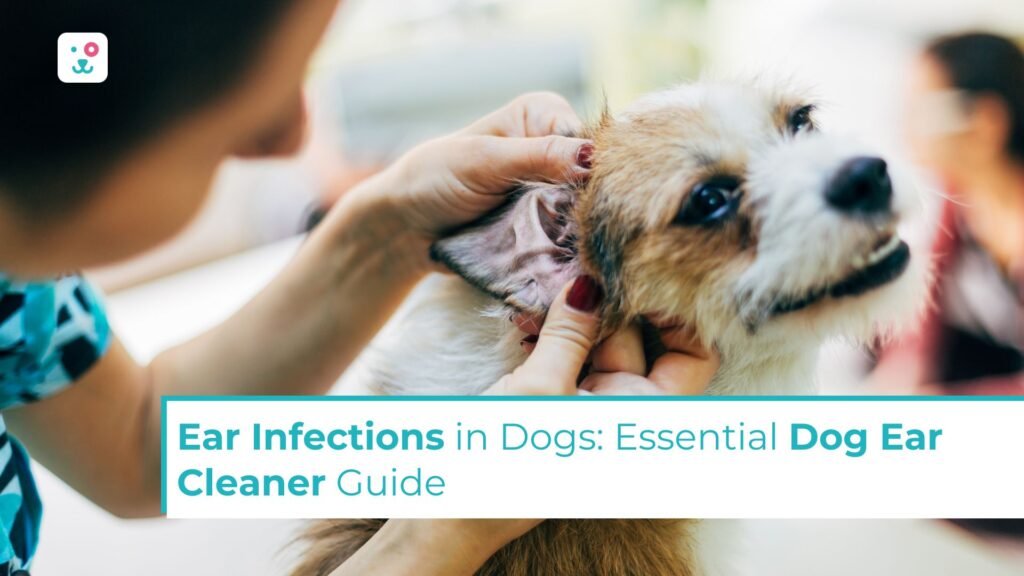Ear infections in dogs are a common health issue that can cause significant discomfort and even lead to severe complications if not addressed promptly. These infections can affect dogs of all breeds and ages, but certain factors increase the likelihood of occurrence. This guide provides an in-depth look at the causes, symptoms, and treatments for ear infections in dogs, along with tips on prevention, including the use of a quality dog ear cleaner.
Understanding Ear Infections
Dog ear infections, also known as otitis externa, occur when the external ear canal becomes inflamed or infected. This condition can be caused by a variety of factors, including bacterial or fungal overgrowth, allergies, ear mites, or trapped moisture. Dogs with long, floppy ears, such as Cocker Spaniels or Basset Hounds, are particularly prone to infections due to poor air circulation in their ear canals.
There are three types of ear infections in dogs:
- Otitis Externa: Involves the external ear canal.
- Otitis Media: Affects the middle ear and often results from untreated otitis externa.
- Otitis Interna: Involves the inner ear and can cause balance issues and hearing loss.
Symptoms of Ear Infections in Dogs
Recognizing the symptoms of ear infections in dogs is essential for timely treatment. Common signs include:
- Frequent head shaking or tilting
- Scratching or pawing at the ears
- Redness and swelling in or around the ear canal
- Foul-smelling discharge, which may be brown, yellow, or bloody
- Crusting or scabbing near the ear
- Sensitivity or pain when the ears are touched
- Loss of balance or coordination in severe cases
If you notice these symptoms, consult your veterinarian for a proper diagnosis and treatment plan.
Also Read – Skin Infection in Dogs – An Important yet Neglected Condition

Causes and Risk Factors
Several factors contribute to ear infections in dogs. These include:
- Moisture: Water trapped in the ears after swimming or bathing creates a breeding ground for bacteria and yeast.
- Allergies: Food or environmental allergies can trigger inflammation and secondary infections.
- Ear Mites: These tiny parasites irritate the ear canal and are a common cause of infections, particularly in puppies.
- Excessive Wax Build-Up: A build-up of earwax can trap debris and promote bacterial growth.
- Foreign Objects: Grass seeds or dirt can lodge in the ear canal, leading to irritation and infection.
- Underlying Conditions: Hypothyroidism and autoimmune diseases can predispose dogs to recurrent ear infections.
Diagnosing Ear Infections
To diagnose an ear infection, your veterinarian will perform a thorough examination of your dog’s ears. This may include:
- Inspecting the ear canal with an otoscope
- Collecting a sample of ear discharge for cytology to identify bacteria, yeast, or mites
- Assessing the overall health of the ear canal and eardrum
Treating Dog Ear Infections
The treatment for ear infections depends on the underlying cause. Your veterinarian may recommend:
- Ear Cleaning: A thorough cleaning to remove wax and debris using a vet-approved ear cleaning solution.
- Medications: Topical or oral antibiotics, antifungal medications, or anti-inflammatory drugs to address the infection.
- Specialized Care: In cases of severe or chronic infections, additional procedures or surgery may be necessary.
Preventing Ear Infections in Dogs
Preventive care is the best approach to avoid ear infections. Here are some tips:
- Regular Ear Checks: Examine your dog’s ears weekly for signs of redness, swelling, or discharge.
- Keep Ears Dry: After swimming or bathing, ensure your dog’s ears are thoroughly dried.
- Routine Cleaning: Use a gentle dog ear cleaner to remove wax and debris. Avoid over-cleaning, as it can irritate the ear canal.
- Manage Allergies: Work with your veterinarian to address food or environmental allergies that could contribute to ear infections.
- Control Parasites: Use preventative treatments for ear mites and other parasites.

How to Use Dog Ear Cleaning Drops Effectively
Cleaning your dog’s ears is a straightforward process that can prevent infections:
- Choose the Right Cleaner: Select a vet-recommended ear cleaning solution tailored to your dog’s needs.
- Prepare Your Dog: Ensure your pet is calm and in a comfortable position.
- Apply the Solution: Gently lift the ear flap and squeeze the ear cleaning drops into the ear canal.
- Massage the Base: Massage the base of the ear to distribute the solution and loosen debris.
- Allow Shaking: Let your dog shake their head to expel excess cleaner and debris.
- Wipe the Outer Ear: Use a soft cotton ball or cloth to clean the outer ear. Avoid using cotton swabs inside the ear canal.
Choosing the Right Dog Ear Cleaner
Selecting a high-quality ear cleaner is essential for maintaining your dog’s ear health. Look for products that:
- Are recommended by veterinarians
- Contain gentle, non-irritating ingredients
- Effectively remove wax and debris
One option to consider is Moe Puppy’s Sensitive Skin Dog Ear Cleaning Solution. This product is specially formulated with natural, soothing ingredients such as aloe vera and chamomile to gently cleanse and protect your dog’s ears. It effectively removes wax, debris, and odor without causing irritation, making it ideal for dogs with sensitive skin. Its alcohol-free and pH-balanced formula ensures a comfortable cleaning experience. Learn more about this product at Moe Puppy.
Final Thoughts
Ear infections can be distressing, but they are preventable with proper care and attention. By understanding the causes and symptoms, adopting preventive measures, and using high-quality products like a vet-approved dog ear cleaner, you can safeguard your dog’s ear health. Regular check-ups and prompt treatment for any signs of infection will ensure your furry companion remains happy, healthy, and free from discomfort.

